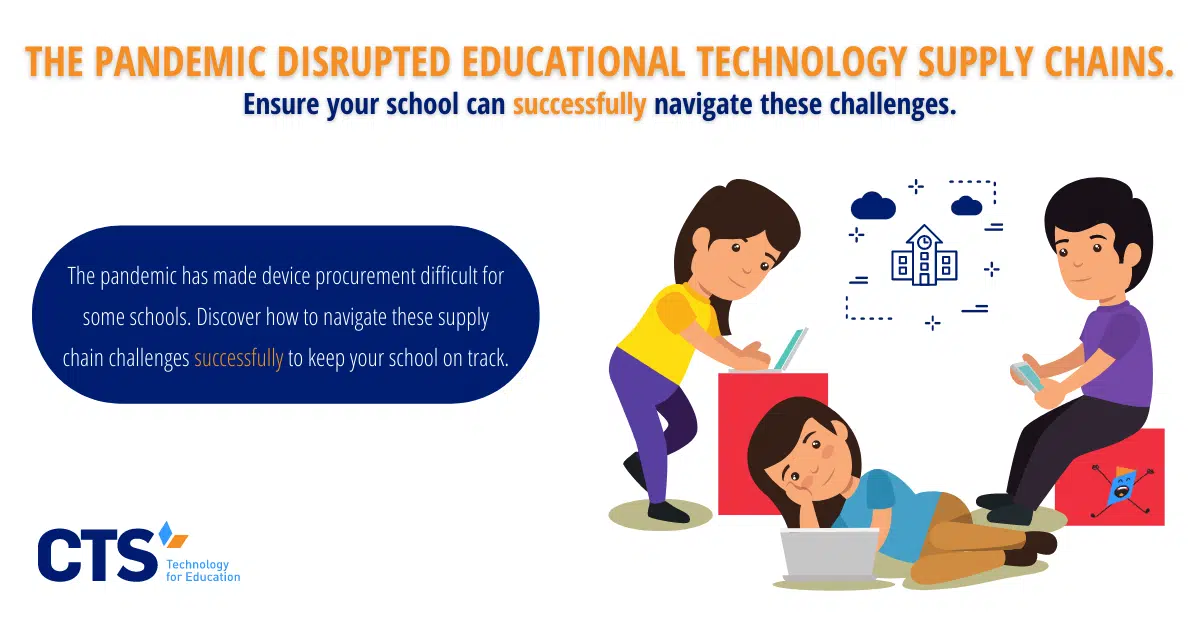Rapid shifts to remote learning accelerated demand for educational technology hardware.
Remote instruction has increased demand for educational technology products like never before. From Chromebooks to video conferencing tools and educational software, schools have sought to mitigate the challenges of distance learning with technology-driven solutions, many of which depend on complex, global supply chains.
Take, for example, a single Chromebook. In addition to its exterior features (screen, keyboard, trackpad, and audio ports), it also includes a host of sophisticated internal components that allow the device to work properly. Each of those individual components, in turn, is comprised of any number of raw materials, which must be sourced, purchased, and shipped to a manufacturing site, often across borders and even entire continents. Disrupt just one step in these complex supply chains, and you have a problem on your hands, one that, in the case of distance learning, threatens to disrupt instruction for millions of U.S. students and their teachers.
Schools that maintained a single Chromebook cart for each grade or even for their entire school were suddenly in need of dozens, if not hundreds, of additional devices in the pandemic’s early days. The scramble for educational hardware in the spring of 2020 occurred across the country, impacting new and more established schools, urban and rural districts alike, many of which lacked the ability to hand each of their students his or her own device.
Unlike some products, hardware like Chromebooks, processors, and video conferencing tools require significant time to produce.
If Chromebooks were, for instance, like toilet paper—perhaps the epitome of pandemic-driven panic shopping—producing additional devices wouldn’t necessarily take that long, or at least demand would gradually subside to pre-pandemic levels. Such was not the case with educational technology. Rather than fear-based consumption, demand for products like Chromebooks, video conferencing tools, and other education technology hardware skyrocketed. More individuals than ever were using these products and, indeed, depended on them to conduct business, communicate with one another, and of course, teach students.
As described above, it isn’t easy for a manufacturer to suddenly produce thousands of additional devices practically overnight. In order to quickly ramp up their production capacity, manufacturers needed to procure enough raw materials from dozens of different suppliers. On top of these logistical challenges, customs issues, border closures, and sometimes conflicting public health regulations across countries further complicated manufacturers’ supply chains.
Many educational technology products depend on Chinese supply chains.
The fact that the pandemic originated in China didn’t help. Many companies, like Lenovo, for example, have a significant manufacturing presence in China, which dramatically shut down large portions of the country for weeks at a time in a bid to quash its initial outbreak.
While the public health outcomes were largely positive, widespread shutdowns wrought further havoc on companies’ supply chains, forcing them to look elsewhere for critical supplies or labor to produce additional devices. With manufacturing in much of China temporarily crippled by the pandemic, schools across the U.S. experienced the economic impacts of the pandemic, which quickly transcended Chinese borders and enveloped the globe.
Trade disputes between the U.S. and China have further complicated schools’ ability to purchase enough Chromebooks for their students.
For the U.S., in particular, companies’ heavy Chinese manufacturing presence and increasing demand for educational technology products were further complicated by tense U.S.-China relations, particularly around trade. Far from facilitating a seamless exchange of labor, products, and capital, the countries’ trade relations stymied even the most valiant attempts by companies to meet the demands of U.S. consumers.
Reports suggested that thousands of products—including educational technology hardware—were simply stuck at U.S. ports waiting to go through customs processing, forced to navigate additional bureaucratic hurdles resulting from the countries’ trade war.
Here, again, U.S. consumers, and particularly school leaders, experienced the economic toll of the pandemic. Without enough Chromebooks to serve their student populations, educators began to devise hybrid learning models and other workarounds that didn’t depend on 1:1 student-Chromebook ratios.
At CTS, we help our partners navigate the challenges of remote learning so they can accomplish their unique missions.
Our team includes former school operations leaders and educational technology experts with the know-how to help your school navigate the challenges of distancing learning. From going above and beyond to source additional hardware to providing longer-term purchasing advice to school leaders, our team is ready to help your school meet the needs of students, no matter the logistical challenges.
We’ve worked with more than 60 schools across the United States to use technology to improve student achievement, all while providing schools with common sense, easy-to-understand payment options.
Contact us today to learn more about our managed IT services and how we can help your school accomplish its unique mission.




